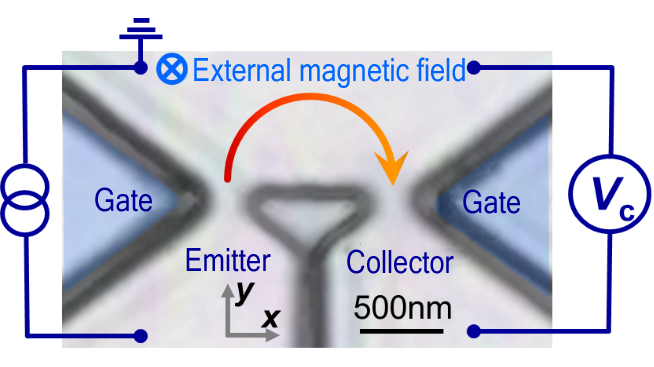News
Research Results
A Method Developed for Efficient Spin Manipulation in Semiconductors: a new method for controlling the rotation of electron spin by using the property of spin-momentum locking
[Highlights]
- Researchers demonstrated a new principle of how to achieve efficient spin manipulation while reducing the spin relaxation.
- The rotation of electron spin is controlled using the property of spin-momentum locking.
- These results hold promise for developing high-speed, energy-efficient power semiconductors, which are essential for artificial intelligence, the Internet of Things, and quantum computing.
[Overview]
A research group consisting of Associate Professor Makoto Kohda, Takanori Okayasu (Master’s Graduate), and Professor Junsaku Nitta at the Graduate School of Engineering, Tohoku University, demonstrated how to control the rotation of high-speed electron spin while reducing the spin relaxation by using a new principle called spin-momentum locking.
Electron spin manipulation in semiconductors is a fundamental technology required for quantum computing and energy-efficient integrated circuit design. There is, however, a critical problem with this technology; when the electron spin precesses around the magnetic field, the spin information will be lost due to spin relaxation.*1 Therefore, the present study demonstrated a new principle that enables efficient spin manipulation by reducing the spin relaxation. In order to reduce the spin relaxation while controlling the spin of electrons, the property of spin-momentum locking*2 is used to align all the spins parallel to the effective magnetic field.*3 The results of this study are expected to contribute significantly to the development of quantum information and spintronics technologies. This study was published online in the British journal “Scientific Reports” by the Nature Publishing Group (NPG) on February 13, 2019 (GMT). This study was supported by the Japan Society for the Promotion of Science through Grants-in-Aid for Scientific Research.
[Research Background]
Electron spin is a magnetic property of electrons. The manipulation of electron spin is a key underlying technology for hardware development for quantum computing and artificial intelligence. Conventionally, the direction of electron spin was controlled by making the electron rotate around the external magnetic field or the effective magnetic field inside the material. However, these methods could not prevent spin relaxation; when electrons rotate simultaneously, they will turn around at slightly different speeds, and therefore their spin information will be lost. This was considered as a major impediment in the development of quantum computing. Thus, it was believed difficult to control the spin of electrons while reducing the spin relaxation.
[Achievements]
Figure 1 shows the device structure used in the present study. This nano-transistor was fabricated from an InGaAs semiconductor quantum well. Electrical currents were fed to the transistor under a weak out-of-plane magnetic field. Due to their cyclotron motion, electrons move in a circular orbit from the emitter to the collector. Their spin directions are shown in Figure 2. While the electrons rotate in a half circle toward the collector, the direction of their spin is inclined by 180° so that it remains parallel to the effective magnetic field inside the material. These electrons do not precess, with all the spins pointing in the direction of the effective magnetic field. This feature, where the direction of the orbital momentum of electrons agrees with that of their spin, is called spin-momentum locking. Because all the electron spins are aligned parallel to the effective magnetic field, the spin relaxation can be reduced while the rotation of electron spin is controlled. Figure 3 shows the experimental and calculated results of the magnetic field dependence of the conductivity of the collector. The conductivity is observed to increase when the spin directions are aligned (as indicated by the red circles in Figure 3). These results are highly consistent with the simulations. Thus, this study demonstrates a new method to control the spin of electrons while reducing the spin relaxation by using the property of spin-momentum locking. This is a promising principle for spin transistor technology, which is used in quantum computing and artificial intelligence.

Figure 1. InGaAs nano-transistor structure fabricated in the present study

Figure 2. Electron spin directions and spin manipulation in the nano-transistor

Figure 3. Experimental (left) and calculated (right) results of the external magnetic field dependence of the collector voltages of spin-polarized and spin-unpolarized currents. The signal is observed to increase only when the current is spin-polarized, which agrees well with the simulated results.
[Publication Information]
Journal: Spin-momentum locked spin manipulation in a two-dimensional Rashba system
Authors: Makoto Kohda, Takanori Okayasu, and Junsaku Nitta
URL: https://www.nature.com/articles/s41598-018-37967-9
DOI: https://doi.org/10.1038/s41598-018-37967-9
[Glossary]
*1 Spin relaxation
It is a phenomenon in which electron spins oriented in the same direction deflect in different directions over time. Because electron spin is not a conservative quantity, it is difficult to keep all the spins aligned in the same direction. The spin relaxation is a major obstacle to using electron spin as an information carrier.
*2 Spin-momentum locking
It is a property of electrons, which have their spin locked perpendicular to their momentum. This is called spin-momentum locking because the spin direction of electrons is settled when the direction of their (orbital angular) momentum is determined.
*3 Effective magnetic field
It is a relativistic effect in which when electrons move at high speeds in an electric field, it transforms into an effective magnetic field. This effect can induce an effective magnetic field acting on the electron spin without using any external magnetic field or ferromagnetic material.
Links:
Tohoku University (Japanese)
Graduate School of Engineering, Tohoku University (Japanese)


